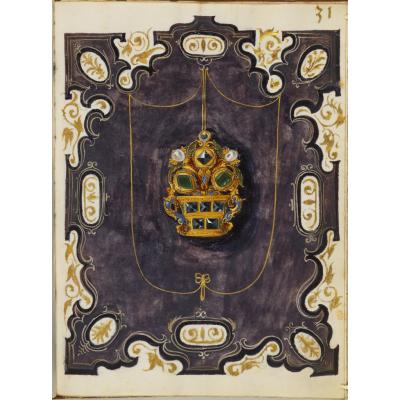
Posted in: Jewelry History
 Point Cut diamonds as illustrated by Hans Mielech in the 'Jewel Book of the Duchess Anna of Bavaria, circa 1552-1555.
The Point Cut represents the first technique in shaping diamonds. At some point during the mid-1400s, the discovery that diamonds cut and polish other diamonds inspired gem cutters to experiment. Since the natural octahedral shape proved the most desirable, these craftsman applied polishing and grinding techniques to coax unruly diamonds into the ideal shape.
Point Cut diamonds as illustrated by Hans Mielech in the 'Jewel Book of the Duchess Anna of Bavaria, circa 1552-1555.
The Point Cut represents the first technique in shaping diamonds. At some point during the mid-1400s, the discovery that diamonds cut and polish other diamonds inspired gem cutters to experiment. Since the natural octahedral shape proved the most desirable, these craftsman applied polishing and grinding techniques to coax unruly diamonds into the ideal shape.
The Octahedral Ideal
India remained the sole source of diamonds from antiquity until the 19th century. Indian culture prized diamonds for their mystical powers. Specifically, they believed that the naturally formed points of octahedral diamonds proved the source of said power. (source) Octahedral refers to a solid geometrical shape containing eight equilateral triangles, four of which connect at their vertices. The resulting shape looks like two pyramids attached together at their bases. Given their beliefs that untouched diamonds proved the most powerful, Indian culture forbade human interference with the stones. Ever searching for diamonds with perfect natural points, miners reserved these most powerful stones for members of the highest caste of society. In actuality, octahedral diamonds represent only one type of diamond crystal habit. Diamonds also form as hexahedrons and dodecahedrons. Furthermore, diamond crystals often form with rounded points, less than ideal according to Indian lore. Prizing only the ideal octahedral diamonds with sharp points, Indian merchants traded away the majority of these less than ideal diamonds. Hence, these undesirable shapes wound up in the hands of European stone cutters. These craftsmen eventually discovered that with a bit of polishing here, a little grinding there, these flawed diamonds transformed into the ideal.The Point Cut
Enter Point Cut diamonds. The name proves somewhat misleading, as in actuality the technique involves only grinding and polishing. This technique allowed cutters to grind away any unwanted mineral matrix adhering to the stone. Furthermore, stone cutters used polishing and grinding techniques to sharpen the points on rounded octahedral diamonds. With such a gentle approach, craftsman transformed unwanted diamonds into the octahedral ideal without leaving any evidence of human tampering. Historians estimate these techniques developed in the mid-1300s. By 1375, the Nurnburg Guild in Germany expanded the technique to include polishing the crystal faces to elicit flawless faces. Beginning in the 1400s, the Point Cut expanded to include techniques which introduced symmetry to otherwise wonky diamonds. These early diamond enhancements remained popular for jewelry well into the mid-1400s. These Point Cut diamonds found their way into almost every kind of jewelry. Romans favored them for rings, while Europeans favored them for brooches like the one pictured above. When set in a piece of jewelry, Point Cut diamonds appear black with a distinctive pyramidal shape.New Techniques
In the mid-1400s, diamond cutters discovered more of diamond's scintillating properties. The first technique employed to increase shimmer and shine was the table cut. Sawing off the top of the octahedron formed a wide table. Acting like a mirror, this table facet shimmered with light, offering a glimpse of the fire waiting to be unleashed from within. Not surprisingly, nearly all of the Point Cut diamonds succumbed to recutting. Few original Point Cut diamonds remain, which is why artists like Hans Mielech, whose work is pictured above, retain historical importance in jewelry history. Though long out of fashion, the Point Cut remains singular in its historical importance. ~Angela Magnotti Andrews5 years ago
5 view(s) 